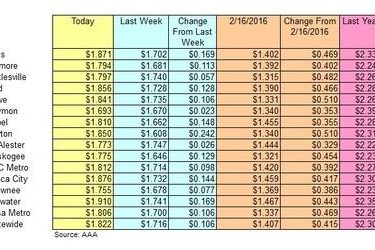State gasoline prices at three-month high
Ponca City Now - March 14, 2016 2:32 pm

Oklahoma’s gas prices are at three-month highs, AAA reports. Today’s statewide average is $1.82 per gallon today, a price Oklahomans haven’t seen since Dec. 8, 2015.
“Prices increased by double digits due to a decline in gasoline supplies, relatively strong demand and continued refinery maintenance,” said Chuck Mai, spokesman for AAA Oklahoma. “Comparatively low oil costs continue to provide drivers with year-over-year savings at the pump.”
Gas prices rose more in the last month in Oklahoma than in any state except Minnesota and Illinois. Retail averages in the vast majority of states (47) are up on the month, and consumers in 35 states have seen prices increase by a dime or more.
Nationwide, gas prices jumped by 12 cents per gallon this week, which is the largest weekly increase since early March, 2015. The national average has moved higher for 18 of the past 20 days for a total of 23 cents per gallon, and today’s price of $1.94 per gallon is the highest average in two months, although it’s 50 cents below the price on this same date last year.
Prices typically move higher at this time of year as gasoline demand begins to increase and refineries conduct seasonal maintenance. This year’s refinery maintenance season is characterized by lower-than-expected prices for crude oil and ample supplies, which should help keep pump prices relatively low compared to recent years.
California ($2.59) regained its spot as the nation’s most expensive market for retail gasoline, and drivers in the state are paying a nickel more per gallon than second-place Hawaii ($2.54). New Jersey ($1.69) and South Carolina ($1.70) are the nation’s least expensive markets for retail gasoline, and a total of six states are posting prices at or below $1.75, which is14 states fewer than a week ago.
Projected reductions in global oil supply and Iran’s slower-than-expected return to the global oil market reportedly contributed to both Brent and West Texas Intermediate closing out the week at 2016 highs. However, oil prices opened this week’s trading session lower on the news that Iran plans to increase oil production significantly. Conversations about when and if the market has reached its bottom persist, and market fundamentals continue to point to supply outpacing demand, which could cause prices to once again turn lower.
The latest data shows that the U.S. oil rig count fell to 386 rigs last week, marking 12 straight weeks of rig-count declines. According to the U.S. EIA, domestic production declined from year-ago levels for the first time in more than four years, largely due to lower-than-expected crude oil prices. Despite this reduction in production, the agency lowered its projections for crude oil prices because domestic production remains more resilient than expected.
At the close of Friday’s formal trading session on the NYMEX, WTI was up 66 cents and settled at $38.40 per barrel, which marked the fourth straight week of oil price increases.



